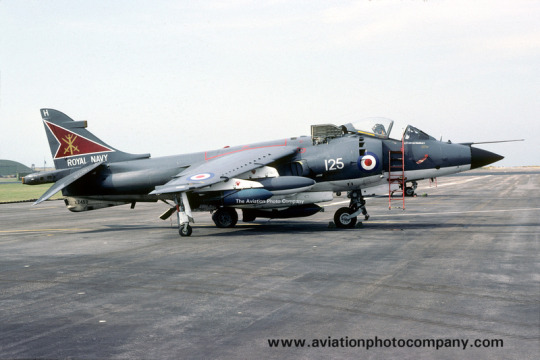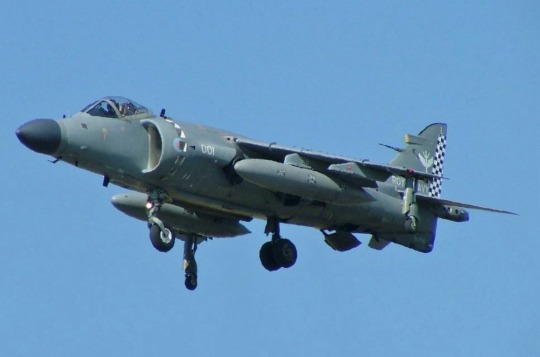#sea harrier FRS.1
Text

A rather potent weapon, here’s an FRS.1 on trials fitted with Sea Eagle ASMs, this aircraft was lost over the Falklands due too its RWR being removed too fit Sea Eagle avionics. #Harrierpres #Seaharrier #flynavy
@Harrierpes via X
#sea harrier FRS.1#hawker siddeley#VTOL#fighter bomber#FAA#royal navy aircraft#aircraft#aviation#carrier aviation#cold war aircraft
14 notes
·
View notes
Text

A Soviet Tu-95 Bear bomber being escorted by a US Navy F-14A Tomcat and a Royal Navy Sea Harrier FRS.1, 1980s
140 notes
·
View notes
Video
British Aerospace Sea Harrier FA.2 ‘XZ497 / 1’ by Alan Wilson
Via Flickr:
c/n 41H-912021, l/n P1, P33 Built in 1982 as a Sea Harrier FRS.1 for the Royal Navy. Served with 801 and 899 Naval Air Squadrons before being converted to an FA.2 in 1988. As the first such conversion she then went to the Aeroplane and Armament Experimental Establishment (A&AEE) at Boscombe Down for trials, but would later return to 801 squadron before being retired. She arrived here in March 2005 and remains ‘out to grass’ along with sister aircraft ZE698. Aerospace Logistics, Charlwood, Surrey, UK 30th April 2022
19 notes
·
View notes
Text

Royal Navy 800 Squadron Hawker Siddeley Sea Harrier FRS.1 -1981-
0 notes
Photo

F-14A Tomcat, Sea Harrier FRS.1 and Tu-95 Bear.
99 notes
·
View notes
Text


Ads for the upcoming Corgi Sea Harrier FRS.1 release.
28 Sea Harriers went to the Falklands and achieved 23 air to air kills (there were also 10 RAF Harriers for ground attack missions). The example Corgi are releasing is XZ457/14 from HMS Hermes.
7 notes
·
View notes
Video
XZ460 BAe Sea Harrier FRS.1, Royal Navy, RNAS Yeovilton, Ilchester, Somerset by Kev Slade
13 notes
·
View notes
Text

-A Hawker Siddeley AV-8A atached to VMA-231 “Ace of Spades”, wearing a rare white and green camo pattern. | Photo: PH1 Rober Bennett
Flightline: 69 - Hawker Siddeley Harrier I
After the cancellation of the P.1154, the RAF went back to the drawing board, and issued a new requirement for a subsonic V/STOL strike aircraft. Hawker Siddeley advanced an upgraded Kestrel, designated P.1127 (RAF), and awarded a contract for six preproduction Harrier GR.1 in 1965, with the first taking flight on 31 August 1966. The RAF ordered 60 production Harriers in early 1967, which officially entered service in 1969. During the same year, Hawker Siddeley formed a partnership with McDonnell Douglas to produce aircraft for the US, though, through that decision was later reversed and the USMC’s order of 102 AV-8A and 8 TAV-8A trainers were produced on Hawker Siddeley’s Kingston upon Thames and Dunsfold factories.

-RAF Harrier GR.1 (the best looking version, don’t @ me) fitted with SNEB rocket pods. | Photo: Mike Freer - Touchdown-aviation
The P.1127/Kestrel KGA.1 and Harrier GR.1/AV-8A are broadly similar in appearance, but the two designs share less than 10% commonality. The Harrier was powered by the more powerful Pegasus 6 engine, and new air intakes with auxiliary blow-in doors were added to produce the required airflow at low speed. Its wing was modified to increase area, and the landing gear was strengthened. Several hardpoints for weapons or drop-tanks were installed, two under each wing and one underneath the fuselage, and provisions for two 30 mm (1.2 in) ADEN cannon gun pods were added to the underside of the fuselage. The Harrier was outfitted with updated avionics to replace the basic systems used in the Kestrel: a navigational-attack system incorporating an inertial navigation system, originally for the P.1154, was installed and information was presented to the pilot by a head-up display and a moving map display. USMC Harriers were further differentiated in that they were built without magnesium components, which were subject to corrosion. They were also fitted with American radios and IFF avionics, and the outer wing pylons were wired to carry AIM-9 Sidewinder missiles for self-defense.

-A USMC AV-8A from VMA-513 (The Flying Nightmares) preparing to land at NAS Whiting Field in 1982. | Photo: USMC
Development of the Harrier continued, with the GR.3 variant being introduced in the early 1980s. Featuring an uprated Pegasus engine, chisel nose incorporating a laser tracker, upgraded avionics and ECM equipment, 62 were converted from earlier GR.1/.1As, while an additional 40 new aircraft were built. In the US, the AV-8As were upgraded to AV-8C specs, mainly involving strengthening the structure and replacing earlier models of the Pegasus engine. During air-combat trials against USMC Phantoms, the Harrier’s pilots developed the concept of “viffing”: rotating the nozzles forward during a turn, which allowed the AV-8s to engage faster targets at close range.

-An RAF GR.3 at Stanley Airport in 1984. | Photo: Petebutt
In the early 1970's the Royal Navy faced the cancellation of the CVA carriers, which would have replaced the Centaur- and Audacious-class full-deck carriers, and as a result began to seek a V/STOL replacement for its Sea Vixen and Phantom FG.1 fighters. The answer came as a result of RN Lt. Cdr. D.R. Taylor’s M.Phil. thesis which postulated that an angled ramp would allow a V/STOL aircraft like the Harrier to take off on smaller decks while still carrying a combat load. Initial testing with various ramp angles was carried out at RAE Bedford, using the two-seat Harrier demonstrator G-VTOL during 1976 and ‘77, and proved that the more the ramp was angled the more of a performance boost was added. As a result, the RN commissioned the new Invincible-class light carriers, which incorporated the newly-christened ski-jump deck. To fly from these ships, Hawker Siddeley developed the Sea Harrier FRS.1.

-A lineup of Sea Harriers (In this camo, the second best looking Harrier. Again, don’t @ me) in 1980. | Photo: Mike Freer - Touchdown-aviation
Based on the upgraded Harrier GR.3, the Sea Harrier was further modified with a raised bubble canopy for improved visibility and a longer nose to incorporate the Ferranti Blue Fox radar. As with the American AV-8A, different alloys were used to prevent corrosion.
FRS.1 and GR.3 Harriers were soon pressed into service during the Falklands Islands War. Sea Harriers operated from the aircraft carriers HMS Invincible and HMS Hermes, acting as the primary air defense, shooting down 20 Argentine aircraft. The RAF’s GR.3s, meanwhile, were operating from two commandeered merchant container ships, Atlantic Conveyor and Atlantic Causeway, which were modified with temporary flight decks. Ten more GR.3s operated from the Hermes.

-Newsweek coverage of the Falklands conflict, showing HMS Hermes carrying Harrier FRS.1. | Screenshot: Newsweek magazine, 19 April 1982.
Along with the US and UK, Spain operated a force of ten Harriers, based on the USMC’s AV-8A, known as the VA-1 Matador, and the Indian Navy ordered a force of 30 (25 fighters and five trainers) Sea Harrier FRS.51 to operate from INS Vikrant (ex-HMS Hercules) and NS Viraat (ex-HMS Hermes).

-An AV-8S (VA-1) Matador of the Spanish Navy. | Photo: PH2 James Bishop

-INS Vikrant circa 1984 carrying a unique complement of Sea Harriers, Sea Hawks, Allouette & Sea King helicopters and Alize ASW aircraft. | Photo: Admiral Arun Prakash (ret.)
The GR.1, GR.3, AV-8A, -8C and Sea Harrier FRS.1 were all retired in the 1980s, and the Spanish Navy sold their VA-1 Matadors to the Thai Royal Navy in 1998. The Thai Harriers were retired in 2008, while the Indian FRS.51 were replaced in 2016 by MiG-29K aircraft.
But the story doesn’t end there....
#aircraft#aviation#avgeek#cold war#cold war history#airplanes#airplane#coldwar#aviation history#hawker siddeley harrier#hawker siddeley#av8a#harrier gr1#harrier#royal navy#usmc#royal thai navy#spanish navy#indian Navy#va1 Matador
9 notes
·
View notes
Photo




Sea Harrier FRS.1 WIP
Work in Progress of an artistic 3D representation of the Sea Harrier FRS.1 with a similar configuration as operated in the battle theater of Malvinas in 1982
0 notes
Text

RN Sea Harrier FRS.1/FA 2 Combat Aircraft Hawaiian Shirt
0 notes
Text

29 Mar 2006 – The Sea Harrier was withdrawn from Fleet Air Arm service and the Harrier GR7/9 fleet was tasked with the missions that it used to share with those aircraft.
In most opinions, a very short sighted decision
@CcibChris🇬🇧🏴via X
27 notes
·
View notes
Video
British Aerospace Sea Harrier FA.2 ‘ZE698 / 123 / 3’ by Alan Wilson
Via Flickr:
c/n B57, l/n P29 Built in 1988 as a Sea Harrier FRS.1 for the Royal Navy. Served with 800, 801 and 899 Naval Air Squadrons before being converted to an FA.2. She then served only with 800 NAS before being retired and stored at RAF St Athan. She arrived here in March 2005 and remains ‘out to grass’ along with sister aircraft XZ497. Aerospace Logistics, Charlwood, Surrey, UK 30th April 2022
18 notes
·
View notes
Text
1/72 Sea Harrier FRS Mk.1 "Falklands" (2 kits) Limited Edition
1/72 Sea Harrier FRS Mk.1 “Falklands” (2 kits) Limited Edition
Striking for the sovereign Argentina thought they could take the Falklands from the Brits. They could. Argentina thought they could keep the Falklands from the Brits. They absolutely could not. A large portion of that inability was due to the Sea Harrier. British warships sailed the length of the globe and smashed the Argentine forces in the area. Sea Harriers were responsible for interdicting…
View On WordPress
0 notes
Photo

Three British Royal Navy FRS.Mk 1 Sea Harrier aircraft parked on the flight deck of the nuclear-powered aircraft carrier USS DWIGHT D. EISENHOWER (CVN 69), 10/22/1984 USN Image
63 notes
·
View notes

